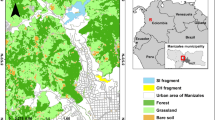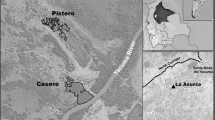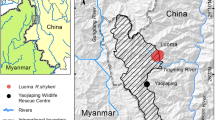Abstract
Most primates live in lowland ecosystems; however, some species have been particularly successful at colonizing higher altitudes, such as night monkeys (genus Aotus). Studies of the ecology of night monkeys in tropical forests are numerous, but behavioral data are limited due to the challenges associated with their nocturnal habits. Although Andean night monkeys (A. lemurinus) live in mountain forests >1000 m.a.s.l. and Caribbean night monkeys (A. griseimembra) live in rainforests <1000 m.a.s.l., they are found at similar tropical latitudes. Between 2018 and 2019, we followed three groups of A. lemurinus and one group of A. griseimembra at three sites in Colombia and recorded data on their ecology and behavior. Although they live at different altitudes, the two species had similar activity patterns and diet, investing approximately half of the night in resting (48%), and feeding primarily on fruits. We found differences among groups in the time invested in feeding on flowers, their home range, and distance traveled per night. These differences may be related to the unique characteristics of each study site and differences in resource availability and floristic composition of forests at different altitudes. Although the most important families in their diet were Moraceae and Urticaceae, highland groups also fed frequently on a large number of Melastomataceae and Rubiaceae trees. This research suggests these two nocturnal primates, living in contrasting environments, use similar strategies to cope with the challenges of being active at night in tropical forests.






Similar content being viewed by others
References
Altmann, J. (1974). Observational study of behavior: Sampling methods. Behavior, 49, 227–267. https://doi.org/10.1163/156853974X00534.
Aquino, R., & Encarnación, F. (1986). Characteristics and use of sleeping sites in Aotus (Cebidae: Primates) in the Amazon lowlands of Peru. American Journal of Primatology, 11, 319–331. https://doi.org/10.1002/ajp.1350110403.
Arditi, S. I. (1992). Variaciones estacionales en la actividad y dieta de Aotus azarae y Alouatta caraya en Formosa, Argentina. Boletín Primatológico Latinoamericano, 3, 11–30.
Bare, M. C., & Ashton, M. S. (2016). Growth of native tree species planted in montane reforestation projects in the Colombian and Ecuadorian Andes differs among site and species. New forests, 47, 333–355. https://doi.org/10.1007/s11056-015-9519-z.
Bicca-Marques, J. C., & Garber, P. A. (2004). Use of spatial, visual, and olfactory information during foraging in wild nocturnal and diurnal anthropoids: A field experiment comparing Aotus, Callicebus, and Saguinus. American Journal of Primatology, 62, 171–187. https://doi.org/10.1002/ajp.20014.
Blanco, M. B., & Rahalinarivo, V. (2010). First direct evidence of hibernation in an eastern dwarf lemur species (Cheirogaleus crossleyi) from the high-altitude forest of Tsinjoarivo, central-eastern Madagascar. Naturwissenschaften, 97, 945–950. https://doi.org/10.1007/s00114-010-0707-6.
Buitrón-Jurado, G., & Ramírez, N. (2014). Dispersal spectra, diaspore size and the importance of endozoochory in the equatorial Andean montane forests. Flora-Morphology, Distribution, Functional Ecology of Plants, 209, 299–311. https://doi.org/10.1016/j.flora.2014.03.009.
Calenge, C. (2006). The package “adehabitat” for the R software: A tool for the analysis of space and habitat use by animals. Ecological Modelling, 197, 516–519. https://doi.org/10.1016/j.ecolmodel.2006.03.017.
Campos, F. A., Bergstrom, M. L., Childers, A., Hogan, J. D., Jack, K. M., et al (2014). Drivers of home range characteristics across spatiotemporal scales in a Neotropical primate, Cebus capucinus. Animal Behaviour, 91, 93–109. https://doi.org/10.1016/j.anbehav.2014.03.007.
Caselli, C. B., & Setz, E. Z. F. (2011). Feeding ecology and activity pattern of black-fronted titi monkeys (Callicebus nigrifrons) in a semideciduous tropical forest of southern Brazil. Primates, 52, 351–359. https://doi.org/10.1007/s10329-011-0266-2.
Castaño, J. H., & Cardona, D. M. (2005). Presencia del mono nocturno andino (Aotus lemurinus I. Geoffroy-St. Hilaire, 1843) en fragmentos de bosque de la cuenca media del río Cauca. Boletín Científico Museo de Historia Natural Universidad de Caldas, 9, 111–120.
Castaño, J. H., Cardona, D., & Botero, J. E. (2010). Ecología del mono nocturno andino (Aotus lemurinus) en fragmentos de bosque subandino en Colombia. In V. Pereira-Bengoa, P. R. Stevenson, M. L. Bueno, & F. Nassar-Montoya (Eds.), Primatología en Colombia: Avances al principio del milenio (pp. 69–90). Bogotá, Colombia: Fundación Universitaria San Martin.
Defler, T. R. (2010). Historia Natural de los Primates Colombianos. Bogotá, Colombia: Conservación Internacional Colombia, Universidad Nacional de Colombia.
Defler, T. R., & Bueno, M. L. (2007). Aotus diversity and the species problem. Primate Conservation, 22, 55–70. https://doi.org/10.1896/052.022.0104.
de Luna, A. G., Link, A., Montes, A., Alfonso, F., Mendieta, L., & Di Fiore, A. (2017). Increased folivory in brown spider monkeys Ateles hybridus living in a fragmented forest in Colombia. Endangered Species Research, 32, 123–134. https://doi.org/10.3354/esr00787.
Dixson, A. F., & Fleming, D. (1981). Parental behaviour and infant development in Owl Monkeys (Aotus trivirgatus griseimembra). Journal of Zoology., 194, 25–39. https://doi.org/10.1111/j.1469-7998.1981.tb04576.x.
Erkert, H. G. (1976). Light-induced activity optimum in night monkeys (Aotus trivirgatus). Folia Primatologica, 25, 186–192. https://doi.org/10.1159/000155712.
Erkert, H. G. (1991). Influence of ambient temperature on circadian rhythms in Colombian owl monkeys, Aotus lemurinus griseimembra. In A. Ehara, T. Kimura, O. Takenaka, & M. Iwamoto (Eds.), Primatology today (pp. 435–438). Philadelphia: Elsevier.
Erkert, H. G., & Grober, J. (1986). Direct modulation of activity and body temperature of owl monkeys (Aotus lemurinus griseimembra) by low light intensities. Folia Primatologica, 47, 171–188. https://doi.org/10.1159/000156276.
ESRI (2018). ArcGIS Desktop (v10.6.1). Redlands, CA: Environmental Systems Research Institute.
Fernandez-Duque, E. (2003). Influences of moonlight, ambient temperature, and food availability on the diurnal and nocturnal activity of owl monkeys (Aotus azarai). Behavioral Ecology and Sociobiology, 54, 431–440. https://doi.org/10.1007/s00265-003-0637-9.
Fernandez-Duque, E., Corley, M., & Spence-Aizenberg, A. (2013). Family Aotidae (Night Monkeys). In R. A. Mittermeier, A. B. Rylands, & D. E. Wilson (Eds.), Handbook of the mammals of the world (Vol. 3, pp. 414–431). Bellaterra, Spain: Lynx Edicions.
Fernandez-Duque, E., de la Iglesia, H., & Erkert, H. G. (2010). Moonstruck primates: owl monkeys (Aotus) need moonlight for nocturnal activity in their natural environment. PLoS ONE, 5, e12572. https://doi.org/10.1371/journal.pone.0012572.
Fernandez-Duque, E., Di Fiore, A., & Carrillo-Bilbao, G. (2008). Behavior, ecology, and demography of Aotus vociferans in Yasuní National Park, Ecuador. International Journal of Primatology, 29, 421–431. https://doi.org/10.1007/s10764-008-9244-y.
Fernandez-Duque, E., & Rotundo, M. (2003). Field methods for capturing and marking Azarai night monkeys. International Journal of Primatology, 24, 1113–1120. https://doi.org/10.1023/A:1026284430453.
Fernandez-Duque, E., & van der Heide, G. (2013). Dry season resources and their relationship with owl monkey (Aotus azarae) feeding behavior, demography, and life history. International Journal of Primatology, 34, 752–769. https://doi.org/10.1007/s10764-013-9689-5.
Ganzhorn, J. U., & Wright, P. C. (1994). Temporal patterns in primate leaf eating: the possible role of leaf chemistry. Folia Primatologica, 63, 203–208. https://doi.org/10.1159/000156820.
García, J. E., & Braza, F. (1987). Activity rhythms and use of space of a group of Aotus azarae in Bolivia during the rainy season. Primates, 28, 337–342. https://doi.org/10.1007/BF02381016.
García-R, S., Montilla, S. O., Bustamante, V., Bustamante, S., Cepeda-Duque, C., et al (2018). Estado de la Investigación Primatólogica en el Eje Cafetero y Antioquia. Neotropical Primates, 24, 56–63.
Gentry, A. H. (1982). Patterns of neotropical plant species diversity. In M. K. Hecht, B. Wallace, & G. T. Prance (Eds.), Evolutionary biology (pp. 1–84). New York: Springer.
Grow, N. B. (2014). Altitudinal distribution and ranging patterns of pygmy tarsiers (Tarsius pumilus). In N. B. Grow, S. Gursky-Doyen, & A. Krzton (Eds.), High altitude primates (pp. 43–59). New York: Springer.
Grow, N. B., Gursky-Doyen, S., & Krzton, A. (2014). High altitude primates. New York: Springer.
Gursky, S. (2000). Effect of seasonality on the behavior of an insectivorous primate, Tarsius spectrum. International Journal of Primatology, 21, 477–495. https://doi.org/10.1023/A:1005444020059.
Guzmán, A., Link, A., Castillo, J. A., & Botero, J. E. (2016). Agroecosystems and primate conservation: Shade coffee as potential habitat for the conservation of Andean night monkeys in the northern Andes. Agriculture, Ecosystems and Environment, 215, 57–67. https://doi.org/10.1016/j.agee.2015.09.002.
Hanya, G., Noma, N., & Agetsuma, N. (2003). Altitudinal and seasonal variations in the diet of Japanese macaques in Yakushima. Primates, 44, 51–59. https://doi.org/10.1007/s10329-002-0007-7.
Helenbrook, W. D., Wilkinson, M. L., & Suarez, J. A. (2019). Habitat use, fruit consumption, and population density of the black-headed night monkey, Aotus nigriceps, in Southeastern Peru. Acta Amazonica, 50, 37–43. https://doi.org/10.1590/1809-4392201900172.
Hemson, G., Johnson, P., South, A., Kenward, R., Ripley, R., & Macdonald, D. (2005). Are kernels the mustard? Data from global positioning system (GPS) collars suggests problems for kernel home-range analyses with least-squares cross-validation. Journal of Animal Ecology, 74, 455–463. https://doi.org/10.1111/j.1365-2656.2005.00944.x.
Khimji, S. N., & Donati, G. (2014). Are rainforest owl monkeys cathemeral? Diurnal activity of black-headed owl monkeys, Aotus nigriceps, at Manu Biosphere Reserve, Peru. Primates, 55, 19–24. https://doi.org/10.1007/s10329-013-0395-x.
Kie, J. G., Matthiopoulos, J., Fieberg, J., Powell, R. A., Cagnacci, F., et al (2010). The home-range concept: Are traditional estimators still relevant with modern telemetry technology? Philosophical Transactions of the Royal Society B: Biological Sciences, 365, 2221–2231. https://doi.org/10.1098/rstb.2010.0093.
Kitayama, K., & Aiba, S. I. (2002). Ecosystem structure and productivity of tropical rain forests along altitudinal gradients with contrasting soil phosphorus pools on Mount Kinabalu, Borneo. Journal of Ecology, 90, 37–51. https://doi.org/10.1046/j.0022-0477.2001.00634.x.
Kleiber, M. (1961). The fire of life: An introduction to animal energetics. New York: John Wiley & Sons.
Körner, C. (1989). The nutritional status of plants from high altitudes. Oecologia, 81, 379–391. https://doi.org/10.1007/BF00377088.
Le Maho, Y., Goffart, M., Rochas, A., Felbabel, H., & Chatonnet, J. (1981). Thermoregulation in the only nocturnal simian: The night monkey Aotus trivirgatus. American Journal of Physiology: Regulatory, Integrative and Comparative Physiology, 240, R156–R165. https://doi.org/10.1152/ajpregu.1981.240.3.R156.
Lehman, S. M. (2014). Effects of altitude on the conservation biogeography of lemurs in southeast Madagascar. In N. B. Grow, S. Gursky-Doyen, & A. Krzton (Eds.), High altitude primates (pp. 3–22). New York: Springer.
Link, A., Mittermeier, R. A., & Urbani, B. (2019). Aotus griseimembra. The IUCN Red List of Threatened Species 2019: e.T1807A17922228. https://doi.org/10.2305/IUCN.UK.2019-2.RLTS.T1807A17922228.en (Accessed April 22, 2020).
Ménard, N. (2002). Ecological plasticity of Barbary macaques (Macaca sylvanus). Evolutionary Anthropology, 11, 95–100. https://doi.org/10.1002/evan.10067.
Montilla, S. O., Cepeda-Duque, J. C., & Bustamante-Manrique, S. (2018). Distribución del Mono Nocturno Andino Aotus lemurinus en el departamento del Quindío, Colombia. Mammalogy Notes, 4, 6–10.
Morales-Jiménez, A. L., & de la Torre, S. (2008). Aotus lemurinus. The IUCN Red List of Threatened Species 2008: eT1808A7651803. https://doi.org/10.2305/IUCN.UK.2008.RLTS.T1808A7651803.en (Accessed April 22, 2020).
Parr, N. A., Melin, A. D., & Fedigan, L. M. (2011). Figs are more than fallback foods: The relationship between Ficus and Cebus in a tropical dry forest. International Journal of Zoology, 72(2011), 1–10. https://doi.org/10.1155/2011/967274.
Pearce, F., Carbone, C., Cowlishaw, G., & Isaac, N. J. (2013). Space-use scaling and home range overlap in primates. Proceedings of the Royal Society B: Biological Sciences, 280, 2012–2122. https://doi.org/10.1098/rspb.2012.2122.
Peres, C. A. (1994). Primate responses to phenological changes in an Amazonian terra firme forest. Biotropica, 26, 98–112. https://doi.org/10.2307/2389114.
Puertas, P., Aquino, R., & Encarnación, F. (1992). Uso de alimentos y competición entre el mono nocturno Aotus vociferans y otros mamíferos, Loreto, Perú. Folia Amazónica, 4, 151–160.
R Core Team (2018). R: A language and environment for statistical computing. Vienna, Austria: R Foundation for Statistical Computing.
Rivera-Díaz, O., Parra-Osorio, C., & Rojas-Rojas, Á. V. (2012). Guía de campo de las plantas con flores de la región del Tequendama, Granja Ecológica El Porvenir (Cundinamarca, Colombia). Bogotá, Colombia: Universidad Nacional de Colombia.
Rothman, J. M., Nkurunungi, J. B., Shannon, B. F., & Bryer, M. A. (2014). High altitude diets: Implications for the feeding and nutritional ecology of mountain gorillas. In N. B. Grow, S. Gursky-Doyen, & A. Krzton (Eds.), High altitude primates (pp. 247–264). Developments in Primatology: Progress and Prospects. New York: Springer Science+Business Media.
Rotundo, M., Fernandez-Duque, E., & Dixson, A. F. (2005). Infant development and parental care in free-ranging Aotus azarai azarai in Argentina. International Journal of Primatology, 26, 1459–1473. https://doi.org/10.1007/s10764-005-5329-z.
Rylands, A. B., Mittermeier, R. A., & Silva, J. S. (2012). Neotropical primates: Taxonomy and recently described species and subspecies. International Zoo Yearbook, 46, 11–24. https://doi.org/10.1111/j.1748-1090.2011.00152.x.
Schmitt, C. B., Denich, M., Demissew, S., Friis, I., & Boehmer, H. J. (2010). Floristic diversity in fragmented Afromontane rainforests: Altitudinal variation and conservation importance. Applied Vegetation Science, 13, 291–304.
Serio-Silva, J. C., Rico-Gray, V., Hernández-Salazar, L. T., & Espinosa-Gómez, R. (2002). The role of Ficus (Moraceae) in the diet and nutrition of a troop of Mexican howler monkeys, Alouatta palliata mexicana, released on an island in southern Veracruz, Mexico. Journal of Tropical Ecology, 18, 913–928. https://doi.org/10.1017/S0266467402002596.
Shanee, S., Allgas, N., & Shanee, N. (2013). Preliminary observations on the behavior and ecology of the Peruvian night monkey (Aotus miconax: Primates) in a remnant cloud forest patch, north eastern Peru. Tropical Conservation Science, 6, 138–148. https://doi.org/10.1177/194008291300600104.
Shanee, S., Allgas, N., Shanee, N., & Campbell, N. (2015). Distribution survey, ecological niche modelling and conservation assessment of the Peruvian Night Monkey: Aotus Miconax Thomas, 1927 (Mammalia: Primates: Aotidae) in north-eastern Peru, with notes on the distributions of Aotus spp. Gray, 1870. Journal of Threatened Taxa, 7, 6947–6964. https://doi.org/10.11609/JoTT.o4184.6947-64.
Solano, C. (1995). Patrón de actividad y área de acción del mico nocturno Aotus brumbacki HERSHKOVITZ, 1993 (Primates: Cebidae), Parque Nacional Natural Tinigua, Meta. Dissertation thesis. Bogotá, Colombia, Departamento de Biología, Facultad de Ciencias, Pontificia Universidad Javeriana, Colombia.
Southwick, C. H., Yongzu, Z., Haisheng, J., Zhenhe, L., & Wenyuan, Q. (1996). Population ecology of rhesus macaques in tropical and temperate habitats in China. In J. E. Fa & D. G. Lindburg (Eds.), Evolution and ecology of macaque societies (pp. 95–105). Cambridge: Cambridge University Press.
Stevens, G. C. (1992). The elevational gradient in altitudinal range: An extension of Rapoport's latitudinal rule to altitude. The American Naturalist, 140, 893–911. https://doi.org/10.1086/285447.
Stevenson, P. R. (2006). Activity and ranging patterns of Colombian woolly monkeys in North-Western Amazonia. Primates, 47, 239–247. https://doi.org/10.1007/s10329-005-0172-6.
Stevenson, P. R., Guzmán, D. C., & Defler, T. R. (2010). Conservation of Colombian primates: An analysis of published research. Tropical Conservation Science, 31, 45–62. https://doi.org/10.1177/194008291000300105.
Stevenson, P. R., Suescún, M., Aldana, A. M., Cano, A., Umaña, M. N., et al (2012). Diversidad arbórea en bosques de tierras bajas en Colombia: Efectos del ambiente, las perturbaciones y la geografía. Hipótesis, 12, 29–35.
Terborgh, J. (1983). Five new world primates: A study in comparative ecology. Princeton, NJ: Princeton University Press.
Vargas, W. G. (2002). Guía ilustrada de las plantas de las montañas del Quindío y los Andes Centrales. Manizales, Colombia: Universidad de Caldas.
Wartmann, F. M., Juárez, C. P., & Fernandez-Duque, E. (2014). Size, site fidelity, and overlap of home ranges and core areas in the socially monogamous owl monkey (Aotus azarae) of northern Argentina. International Journal of Primatology, 35, 919–939. https://doi.org/10.1007/s10764-014-9787-z.
Wenyuan, Q., Yongzu, Z., Manry, D., & Southwick, C. H. (1993). Rhesus monkeys (Macaca mulatta) in the Taihang mountains, Jiyuan county, Henan, China. International Journal of Primatology, 14, 607–621. https://doi.org/10.1007/BF02215450.
Whiten, A., Byrne, R. W., & Henzi, S. P. (1987). The behavioral ecology of mountain baboons. International Journal of Primatology, 8, 367–388. https://doi.org/10.1007/BF02737389.
Wright, P. C. (1978). Home range, activity pattern, and agonistic encounters of a group of night monkeys (Aotus trivirgatus) in Peru. Folia Primatologica, 29, 43–55. https://doi.org/10.1159/000155825.
Xiang, Z. F., Huo, S., Xiao, W., Quan, R. C., & Grueter, C. C. (2007). Diet and feeding behavior of Rhinopithecus bieti at Xiaochangdu, Tibet: Adaptations to a marginal environment. American Journal of Primatology, 69, 1141–1158. https://doi.org/10.1002/ajp.20412.
Xiang, Z. F., Liang, W. B., Nie, S. G., & Li, M. (2012). Diet and feeding behavior of Rhinopithecus brelichi at Yangaoping, Guizhou. American Journal of Primatology, 74, 551–560. https://doi.org/10.1002/ajp.22008.
Zhuang, L., Tian, Z., Chen, Y., Li, W., Li, J., & Lu, S. (2012). Community characteristics of wild fruit forests along elevation gradients and the relationships between the wild fruit forests and environments in the Keguqin Mountain region of Iii. Journal of Mountain Science, 9, 115–126. https://doi.org/10.1007/s11629-012-2009-2.
Zuidema, P. A., Sayer, J. A., & Dijkman, W. (1996). Forest fragmentation and biodiversity: the case for intermediate-sized conservation areas. Environmental Conservation, 23, 290–297. https://doi.org/10.1017/S037689290003914X.
Acknowledgments
The authors thank the National Geographic Society (Grant EC-323R-18), the Global Wildlife Conservation Primates Action Fund, and the Margot Marsh Biodiversity Foundation (Grant No. 5236.005-0255) for funding the field phase and facilitating the long-term establishment of the night monkey project in Colombia. Fundación Proyecto Primates also provided valuable logistical and financial support for the study. We thank the Lalinde and De Greiff families, who have allowed primate research at San Juan de Carare over the past 13 years; the Montilla family and Rubén Orozco for allowing us to carry out this research on their property and facilitating our accommodation in Pijao; and Shella Ovalle and Raúl Ladino for accommodating us in their home in the Cuchilla de Peña Blanca reserve and for all the logistical support provided during the project. We sincerely thank Sandra Gomez (Fundacion Ingenial Colombia) and biologist Danilo Santos for the support and logistical facilities given with the Tequendama group.
Author information
Authors and Affiliations
Contributions
SOM and AL conceived and designed the study. SOM, AMMC, LNSM, JDMT, OMCR, JMC, DAGB, JAHV, CJA, LPG, MCM, NJCD, EACD, AHCC, EFP, and AMRO conducted the fieldwork. SOM and AL performed data analysis and wrote the manuscript.
Corresponding author
Additional information
Handling Editor: Joanna Setchell
Supplementary Information
ESM 1
(DOCX 60.9 kb)
Rights and permissions
About this article
Cite this article
Montilla, S.O., Mopán-Chilito, A.M., Murcia, L.N.S. et al. Activity Patterns, Diet and Home Range of Night Monkeys (Aotus griseimembra and Aotus lemurinus) in Tropical Lowland and Mountain Forests of Central Colombia. Int J Primatol 42, 130–153 (2021). https://doi.org/10.1007/s10764-020-00192-1
Received:
Accepted:
Published:
Issue Date:
DOI: https://doi.org/10.1007/s10764-020-00192-1




